

 |
 |
Responding to a 15-17 Notrump – Part II
5-5 Majors
How Good Is: Axxxx . Kxxxx . x . xx
You pick up a 5.5.1.2 hand with an ace and a king in your long suits. Is this collection worthy of a game invitation opposite partner's opening notrump? How much should opener need to accept game? SIM can tell us such things.
For these studies, opener is dealt one of the three "normal"
hand patterns, with no 5-card major. Ten-spots are
randomly included. Game is invited via
1NT–3♥, while a 2-level
signoff is implemented Garbage-Stayman style, by
1NT-2♣-2♦-2♥.
After a game invitation, opener prefers spades unless the hearts are
longer, so as to declare from the strong side. All analyses are for
1,000 deals each.
We'll start with a comparison of signoff versus game invitation.
For the moment, opener will accept game with any hand containing 16-17 hcp
or a 4-card fit:
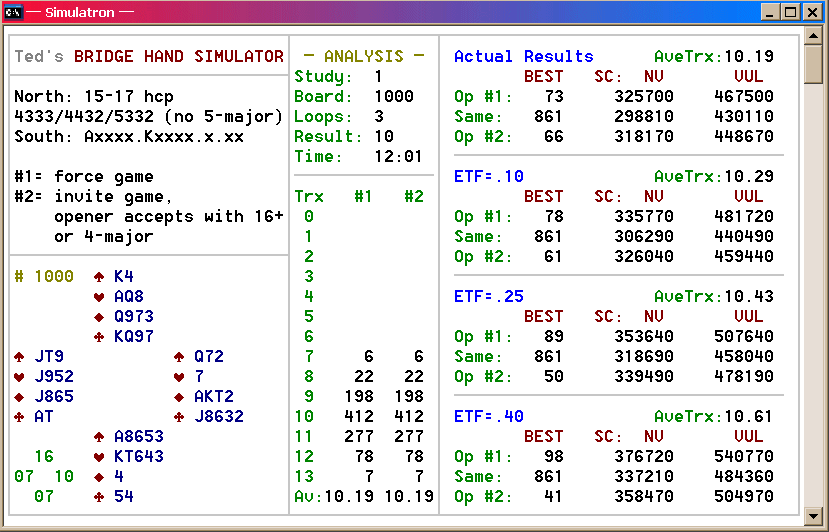
Amazing! The Average Trick Rating
(ATR) is 10.19, and game actually
can be made 79% of the time in this run, even against
competent opponents. Are you surprised?
Perhaps we shouldn't even bother inviting — just force to
game! A more comprehensive valuation of opener's hand might
be useful; perhaps game should be bid with any 4-card
major fit, or rejected if holding potentially wasted minor-suit
values. The next chart shows what can be expected from a
variety of bidding strategies, in order of effectiveness:
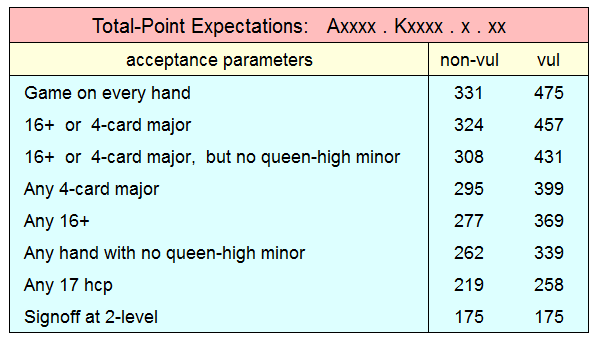
It appears that this hand is good enough to
force a game! The evaluation comparisons are revealing
as well. Although the analysis covers but a single
honor-configuration, the general pattern should
reasonably apply to other high-card combinations.
* Accept with any 16+ hcp.
* Accept with any 4-card major fit.
* Devaluation of "poor" minor-suit holdings is ineffective.
Hands with 7 HCP
The following chart utilizes what seems to be a viable acceptance
strategy — 16+ hcp or a 4-card major fit:
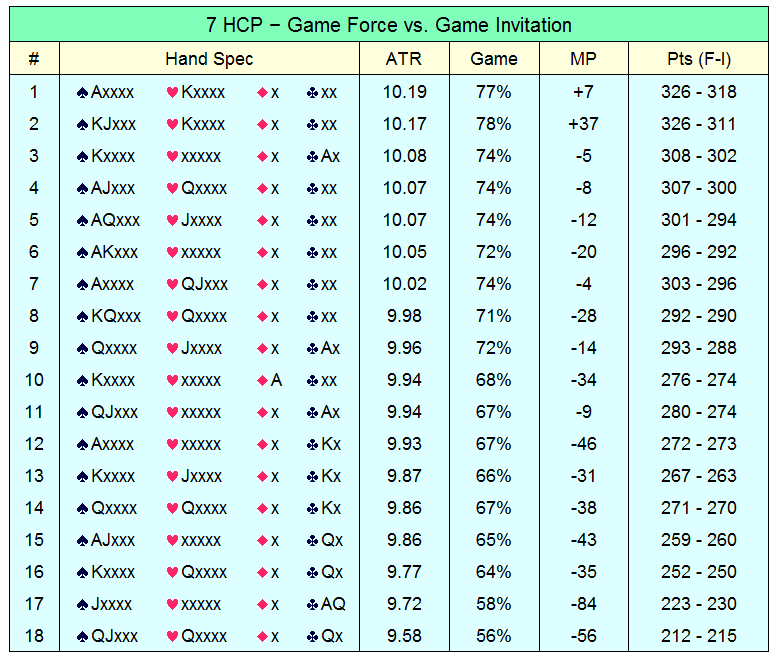
Somehow it is not surprising that hands #1 and #2 fare
significantly better than the others. Only those two have a control
in each major; that must be the key. The positive MP ratings indicate
that game should be reached with these two holdings, even at matchpoints.
At imps, all but #17-18 score best overall by simply forcing a game! Moreover, when vulnerable or if your ETF is high, the potential rewards are even greater.
As the other patterns score better on average than if every contract were
a part-score, all are worthy of a game invitation.
Even those with Qx in a minor are better than they
may look.
* At any form of scoring, force to game with a
control-card in each major.
* At imps, force to game with any unflawed 7-count.
What Is the Minimal Game Invitation?
It remains to determine the minimal hand that is likely to
produce a game. Let's look at some hands in the
4-7 hcp range. For this group:

The only invitation here is #18, which is a carryover from the previous chart.
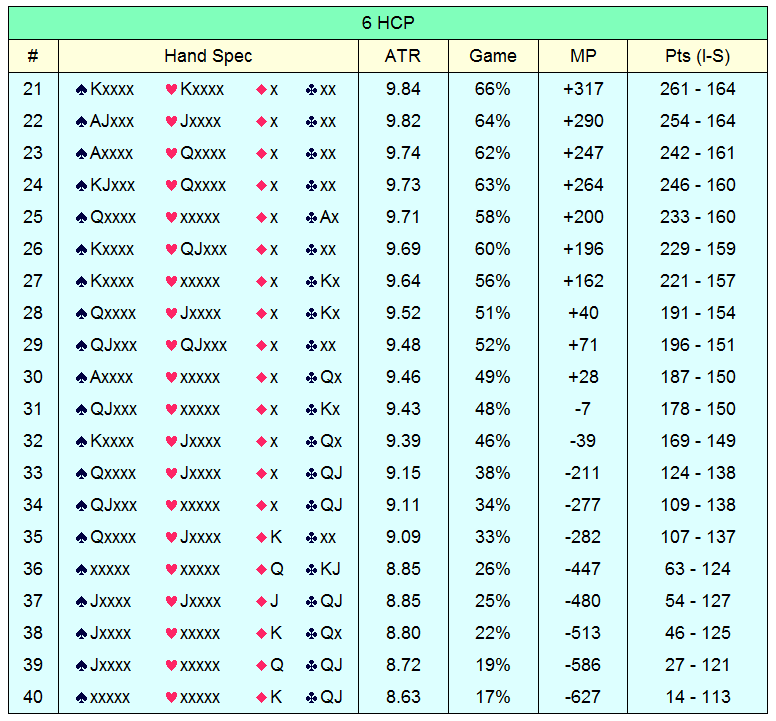
Although not indicated on this graph, hands #21-22 are best forced
to game at imps! #21-30 are clear-cut invitations
even at matchpoints. #31-32 are worth a try at imps,
even when non-vulnerable and even against good defenders.
The remaining patterns illustrate the danger of over-valuing unguarded
honors; such holdings are not legitimate 6-counts and should not
be treated as such.
Note that hand #28 outscores #31 just by moving the spade
jack into the heart suit; apparently, having an honor in each major is worth
more than the QJ combination.
* Invite game with any decent-looking 6-count.
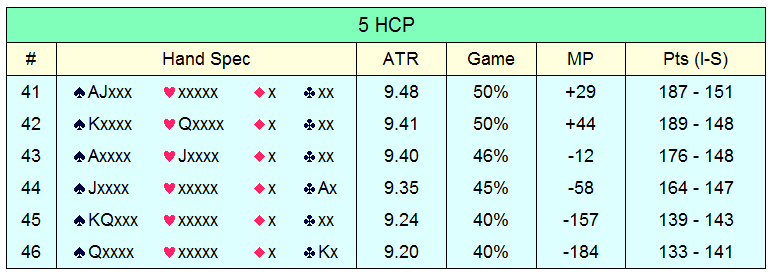
Who would invite game with a 5-count? Is this a joke?
My answer is to look at the numbers. Hands #41-42 are
odds-on invitations in any type or class of game!
#43-44 are total-point gainers as well.
Is this the end of the line? How much deeper can we dig? Let's try one more level:
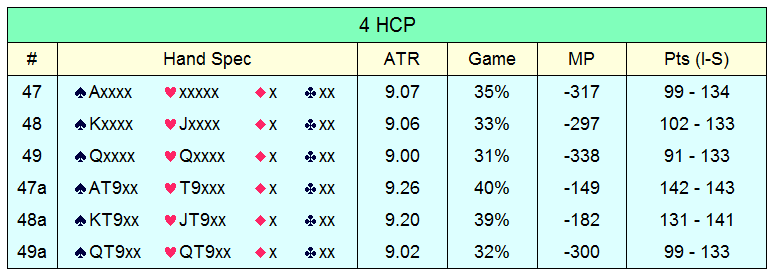
Okay, perhaps this was a bit optimistic; but wait — look at
the specs for hand #47a:
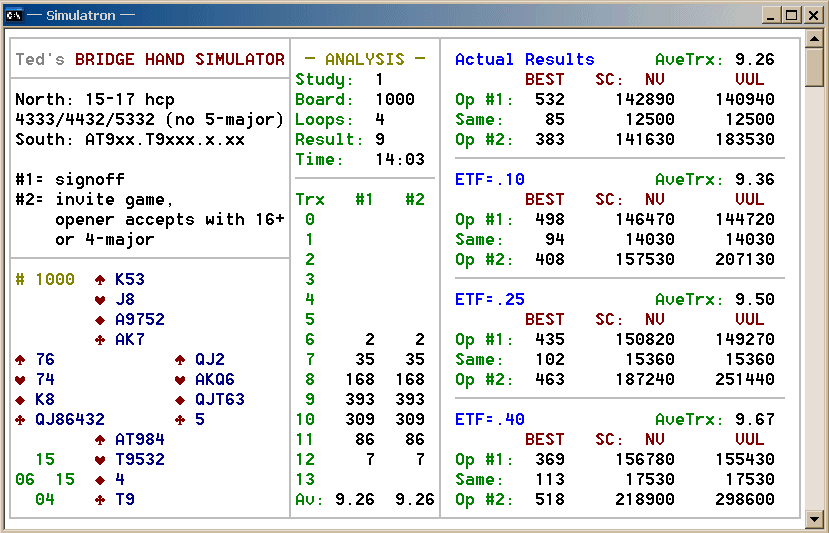
When vulnerable at imps, inviting game averages an additional
40 points per hand! Not evident from the chart,
however, is that without the pair of 10-9
combinations the point totals go down more than 25%,
rendering it a poor game proposition; that says a lot for those
spot-cards.
Similarly, inviting with hand #48a generates 27+
additional points per hand, when vul at imps. #49a
fared quite poorly, doubtless due to its lack of any control card.
* At imps, vul, consider inviting with a
major-suit control card and good spots.

Conclusions
A 5-5 yarborough is a 9-loser hand. A 1NT
opening bid might provide 5 cover cards, or the equivalent in ruffing
values. So if responder has anything at all, game is possible!
Any Scoring
* Force to game with a 64% chance of success; invite game with 48%.
* Force to game with a control card in each major.
* Invite game with any 6-count without a flaw.
* Sign off with up to 7 hcp including a doubleton QJ or singleton K.
* Opener should accept game with 16+ hcp or a 4-card major fit.
Imps
* Force to game with any reasonable 7-count.
Note: Remember that these conclusions are based upon the
restriction that opener is not 2-2 in the majors. If he might
have such a hand, then game prospects are not as good. This contingency
might be addressed in a future study.